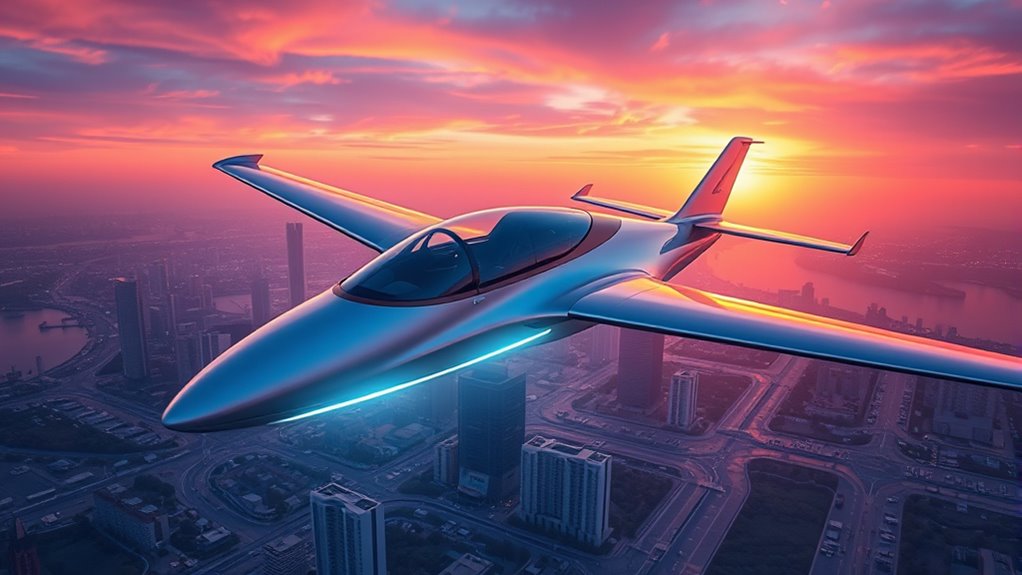Electric flight is transforming air travel through advances in energy storage, propulsion, and sustainable tech. Lithium-ion batteries and hydrogen fuel cells improve energy density, making electric aircraft feasible for regional flights. Hybrid designs and innovations like advanced electric motors boost efficiency, reduce emissions, and lower costs. These breakthroughs promise quieter, greener planes that will reshape how we fly. To discover how these innovations are shaping the future of aviation, keep exploring this exciting evolution.
Key Takeaways
- Advances in energy storage, like solid-state batteries and hydrogen fuel cells, are critical for enabling long-range electric flights.
- Hybrid-electric aircraft combine traditional engines with electric motors to reduce emissions and extend operational range.
- Electric propulsion technologies, such as PMSMs and direct-drive motors, improve efficiency, reliability, and noise reduction.
- Fully electric aircraft offer zero emissions, lower operating costs, and support sustainable aviation goals globally.
- Industry growth is driven by technological innovations, government support, and infrastructure development for widespread adoption.

Have you ever wondered how electric flight is transforming the future of aviation? The rapid advancements in battery scalability and hydrogen storage are at the heart of this revolution. Today’s lithium-ion batteries, offering around 300 Wh/kg, limit the size and range of electric aircraft, especially for larger planes. To enable regional and cargo flights, researchers are pushing for breakthroughs in energy density. MIT-developed fuel cell technology, targeting over 1000 Wh/kg, promises to make electric regional flights feasible, but reaching transcontinental ranges still requires further R&D. Meanwhile, hydrogen storage stands out as a game-changer—hydrogen boasts a gravimetric energy density 100 times greater than lithium-ion batteries. However, volumetric storage remains a challenge, as it demands innovative solutions to safely and efficiently store hydrogen onboard aircraft. Overcoming these hurdles will be *pivotal* for long-haul electric aviation, which remains dependent on breakthroughs like solid-state batteries or hydrogen fuel cells.
In the meantime, hybrid-electric aircraft serve as a *key* transitional technology. Combining traditional engines with electric motors, these planes reduce fuel consumption and emissions while extending operational range. They also provide propulsion redundancy, enhancing safety. Designed primarily for short- and mid-range routes, hybrid systems help airlines lower their environmental footprint immediately, bridging the gap until battery and charging infrastructure mature. This gradual approach offers a practical pathway for the industry to transition from fossil fuels toward fully electric powertrains, aligning with global sustainability goals.
Advances in electric propulsion technology further accelerate this shift. Permanent Magnet Synchronous Motors (PMSMs) now deliver higher efficiency, increased power density, and quieter operation. Using permanent magnets, these motors reduce energy loss, generate more torque, and allow for more compact designs. Innovations like direct-drive motors eliminate the need for gearboxes, decreasing weight, complexity, and maintenance costs. These improvements not only make aircraft more reliable but also open doors for innovative designs and potential in-flight energy regeneration. Such motor tech enhances the operational feasibility of electric aircraft, especially as battery and fuel cell capabilities evolve. Additionally, ongoing research in sound design aims to develop quieter electric propulsion systems, improving passenger comfort and reducing noise pollution around airports.
The environmental benefits of electric flight are compelling Fully electric aircraft produce zero CO2 emissions during operation, and if powered by renewable energy, their total lifecycle impact drops *considerably*. Lower maintenance costs, fewer moving parts, and higher reliability make electric planes more economical in the long run. Countries like Norway aim for all domestic and short-haul flights to be electric by 2040, reflecting strong governmental support. As battery scalability and hydrogen storage solutions improve, electric aviation will increasingly complement sustainable aviation fuels, contributing to a cleaner, more efficient future in air travel.
Frequently Asked Questions
What Are the Safety Concerns With Electric Aircraft?
You should be aware of safety concerns like battery safety and charging infrastructure. Lithium-ion batteries in electric aircraft can face thermal runaway, increasing fire risks. Proper thermal management is essential, and emergency procedures must address battery fires, which are tough to extinguish. Additionally, inadequate charging infrastructure can limit flight range and safety margins, making reliable charging stations vital for safe operation and emergency readiness.
How Long Does an Electric Flight’s Battery Last?
Think of your electric aircraft’s battery as a marathon runner, steadily losing energy as miles pass. Typically, the battery’s longevity depends on its energy capacity, lasting around 31 minutes for a 460 kWh pack under ideal conditions. As it discharges, performance drops. Advances aim to boost energy density, allowing longer flights. For now, you can expect a limited window before needing a recharge, making it suitable for short, efficient hops.
Are Electric Planes More Cost-Effective Than Traditional Jets?
You’ll find electric planes can be more cost-effective than traditional jets for short to medium routes, mainly due to better fuel efficiency and lower energy costs. Battery technology improves steadily, reducing maintenance and operational costs. While initial infrastructure investments are high, ongoing savings from cheaper electricity and fewer moving parts make electric aircraft an economically attractive choice, especially as technology advances and economies of scale kick in.
What Infrastructure Is Needed for Widespread Electric Flight?
You’ll need a robust network of charging stations and a power grid capable of handling immense demand. Strategically select sites near electrical utility lines and guarantee they’re compatible with aircraft standards. Upgrades to the grid, on-site energy storage, and renewable integration are essential. Engage stakeholders early, update airport layouts, and plan for multiple charging standards to ensure seamless, widespread electric flight infrastructure that transforms air travel into a cleaner, faster future.
How Will Electric Flight Impact Airline Schedules?
Electric flight will substantially impact your airline scheduling by requiring longer turnaround times due to battery charging needs. You’ll need to contemplate battery technology advancements and charging infrastructure to optimize schedules, possibly reducing flight frequency or consolidating routes. Power availability, renewable energy patterns, and grid constraints also influence timing. Using advanced scheduling tools, you can better coordinate charging and flights, ensuring smooth operations while managing the operational constraints introduced by electric aircraft.
Conclusion
As you explore the future of air travel, remember that electric aircraft could cut emissions by up to 90%, transforming the skies. With advancements happening rapidly, you’re on the brink of witnessing a cleaner, quieter, and more efficient way to fly. The industry’s shift toward electric flight is not just a trend but a revolution, promising a sustainable future where innovation takes flight. Stay excited—your journey toward eco-friendly travel is just beginning.








